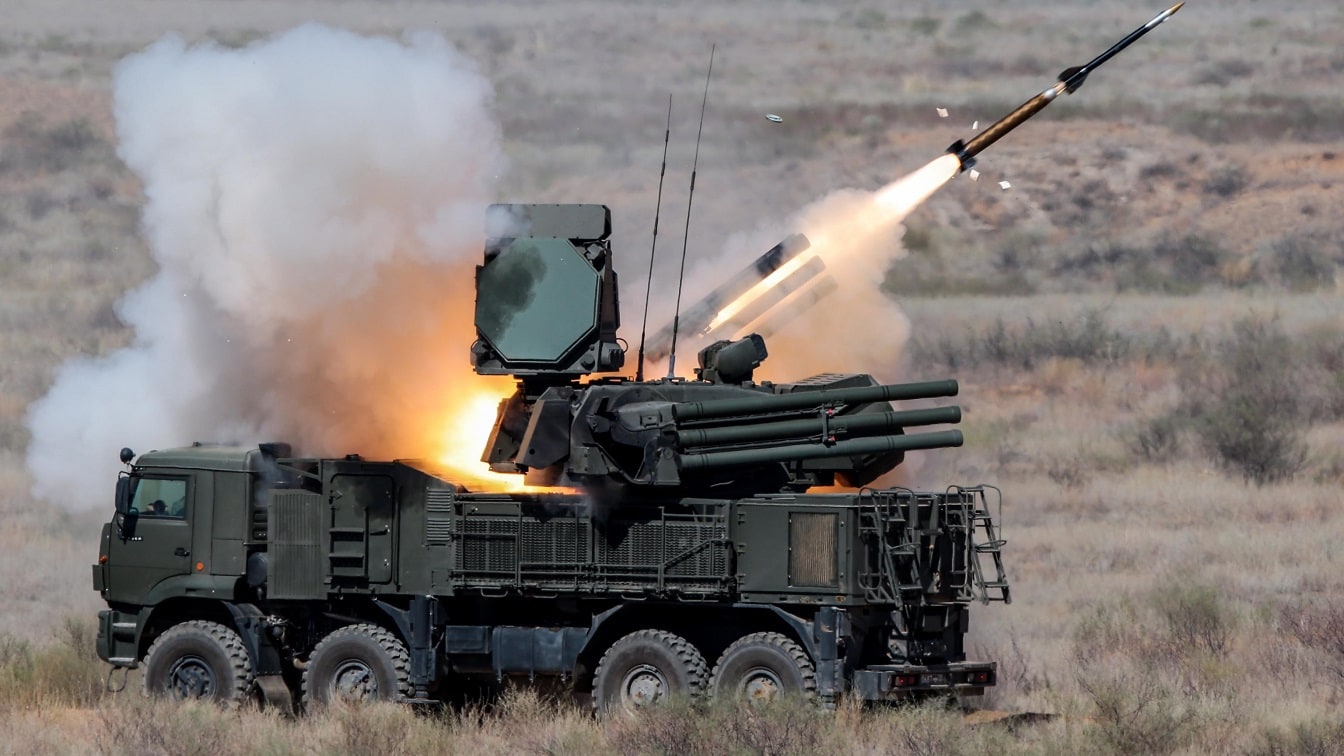Russia has announced that the testing phase for the enhanced iteration of one of its most advanced air defense systems, Pantsir, featuring a tracked chassis, is nearing completion.
This new configuration enables the system to effectively accompany and protect air defense systems during movements in snow and off-road terrains.
The state corporation Rostec told state-run TASS that the test of this upgraded system, the Pantsir-SM-SV anti-aircraft missile-gun system (ZRPK), is in its final stage.
“The Shipunov Instrument Design Bureau (part of the High-Precision Complexes holding of the Rostec State Corporation) is currently completing tests of the Pantsir-SM-SV air defense missile system as part of development work,” the corporation said.
The tests have affirmed the system’s compliance with the requirements set forth by the Ministry of Defense of the Russian Federation.
The Pantsir-SM-SV, specifically crafted to safeguard the Ground Forces of the Russian Federation, stands out due to its installation on a “caterpillar chassis.”
“With it, the complex will be able to accompany and cover air defense systems on the march in snow and off-road, the report pointed out.
Additionally, the system is equipped with two varieties of anti-aircraft guided missiles and boasts an expanded kill zone.
The Pantsir-SM-SV’s deployment within the armed forces will significantly enhance air defense capabilities, particularly in low-altitude and close-range scenarios. However, the company refrained from specifying a precise date to complete tests and the subsequent deployment of these upgraded systems to the Russian armed forces.
Nonetheless, the enhanced version holds significant importance for the Russian armed forces.
In earlier stages of the conflict, several of these air defense systems had to be abandoned due to getting stuck in the mud, highlighting the significance of the forthcoming improvements.
The operational flexibility of the Pantsir system will be significantly enhanced by its capacity to function in various terrains. This is crucial for enabling air defense units to swiftly adapt to evolving battlefield conditions and respond promptly to emerging threats.
Pantsir-SM-SV Air Defense System
The development of the upgraded anti-aircraft missile-gun system, designated as the Pantsir-SM-SV, has faced delays compared to the original schedule.
Although limited details about the system are currently available, representatives from the Russian Rostec announced during the MILEX 2023 exhibition in Minsk that the testing phase for the Pantsir-SM-SV was reaching its final stage.
According to statements by the company at the exhibition, the Pantsir-SM-SV has undergone refinement based on the experiences gained during the conflict with Ukraine.
The system is expected to exhibit enhanced capabilities, including intercepting drones, counter barrage munitions, and target GMLRS-guided missiles used by the M142 HIMARS systems.
Several defense experts suggest that the configuration of the Pantsir-SM-SV system represents a significant “return” to the initial concept of the 2K22 Tunguska gun/missile air defense system, known by its NATO reporting name SA-19 Grison.

Adapting the “Pantsir-SM-SV” for the Ground Forces necessitates the integration of two distinct variants of guided anti-aircraft missiles and an extended engagement range.
The anti-aircraft gunner crew operating the combat vehicle can employ existing MANPADS systems like Igla, Igla-S, and Verba, in addition to the anticipated next-generation MANPADS named Metka.
Furthermore, the system incorporates the ‘Ptitselov’ surface-to-air missile (SAM) system, which comprises two unique missile variants utilizing different guiding techniques—specifically, infrared homing and laser guidance.
This advanced system enhances the overall defensive capabilities of the Pantsir-SM-SV, offering a comprehensive solution for contemporary aerial threats.
Integrating a tracked chassis in the Pantsir system is a pivotal advancement, mitigating the risk of potential immobilization in challenging terrains like mud or rough landscapes.
This enhancement will also minimize vulnerability and bolster the system’s reliability and efficacy even in adverse weather or challenging ground conditions.
With the tracked chassis, the system can be swiftly and efficiently dispatched to critical areas and offer timely and robust air defense support precisely where it is most needed.
Adopting a tracked chassis marks a transformative upgrade for the Pantsir system, substantially elevating its mobility, adaptability, and overall battlefield effectiveness.
This directly addresses operational limitations associated with wheeled systems, positioning the Pantsir as an indispensable asset for the Russian forces in asserting air superiority and safeguarding ground assets.
- Contact the author at ashishmichel(at)gmail.com
- Follow EurAsian Times on Google News




